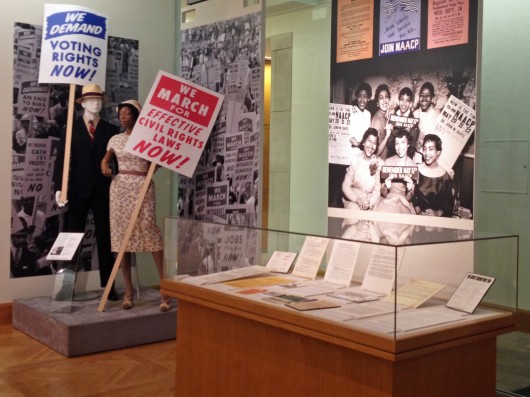
“Remembering the Act: Archival Reflections on Civil Rights,” is on display until Jan. 4 at Thompson Library. The exhibit commemorates 50 years since the enacting of the Civil Rights Act of 1964.
Credit: Krista McComb / Lantern reporter
Nearly 50 years after the Civil Rights Act of 1964 was enacted, Ohio State is remembering the role Ohioans played in helping stop racial discrimination in the workplace.
In honor of the anniversary, the Thompson Library has put together an exhibit called “Remembering the Act: Archival Reflections on Civil Rights” that focuses on the history of civil rights on a national scale and also narrows the focus to history in Columbus. And at least one student said the exhibit is important given the recent racially-charged protests in Ferguson, Mo.
Materials shown in the exhibit are from a variety of special collections including the Ohio Congressional Archives, University Archives, the Billy Ireland Cartoon Library and Museum and the Theater Research Institute, said Jeffrey Thomas, the exhibit curator and archivist for the Ohio Congressional Archives at OSU.
The exhibit — which has been roughly nine months in the making — cost about $780 for the creation of information panels, Thomas said, but the rest of the cost is unkown.
The Civil Rights Act of 1964 was the “most far-reaching and significant act of Congress in the 20th century,” Thomas said.
In 1964, the Civil Rights Act passed, making it unlawful for an employer to discriminate against any individual based on their “race, color, religion, sex or national origin,” according to the National Archives.
“(The exhibit) lets people know that racial discrimination was not only associated with the Deep South, but also happened here in Columbus,” Thomas said.
Perhaps a more recent and memorable example of what some felt to be racism at OSU occurred in April 2012 when “Long Live Zimmerman” was spray painted on the side of Hale Hall.
The building was home to the Frank W. Hale Jr. Black Cultural Center, part of the Office of Diversity and Inclusion. Police at the time said the graffiti reference was most likely to George Zimmerman, a neighborhood watch leader who allegedly killed Trayvon Martin in self-defense Feb. 26 2012 in Florida. Martin was black and Zimmerman Hispanic. Zimmerman was found not guilty.
The exhibit specifically looks at the role Ohioans played in getting the act passed. One such Ohioan was William McCulloch, who graduated from the OSU College of Law and served in the Ohio House of Representatives for six terms.
Although McCulloch was instrumental in getting the act passed through the House and Senate, Thomas said, he is not usually recognized for the role he played.
Thomas said he wanted to put together the exhibit to bring light to the role McCulloch played and to give a general overview of civil rights.
Another Ohioan represented in the exhibit is Barbee Durham, an OSU graduate, who was a civil rights activist in Columbus from the 1940s to the 1970s. He was known for his community activism on racism.
The exhibit hosts documents showing discrimination in housing records, segregations of schools and police brutality documentations.
“Discriminatory practices in housing violate the basic rights of all people for equal opportunity to obtain housing,” reads a 1963 fair housing listing service document from the Greater Columbus Committee for Fair Housing, which is part of the exhibit. “Such practices are harmful not only to minority groups but to the entire community, and to our nation in the world community.”
Thomas said he hopes students can learn from the exhibit and see what it was like to be an African-American during the mid-twentieth century.
Some students said now is a good time to remember the Civil Rights Act of 1964.
Shelby Lozan, a fourth-year in exercise science, said the exhibit “shows a big milestone, which is important because of everything that is going on in Ferguson right now.”
On Aug. 9, 18-year-old Michael Brown was fatally shot by a white police officer in Ferguson, Mo. The incident sparked weeks of racially fueled protests.
Aashi Majithia, a first-year graduate student in human resources, said she thinks the recognition of the act is important.
“Everyone should have the choices they want to make in life.” she said.
The exhibit is located in the Thompson Library Gallery on the first floor. It’s open weekdays from 10 a.m. to 6 p.m. and 12 to 6 p.m. on weekends. The exhibit is set to run from Sept. 13 through Jan. 4. Admission is free.
![Ohio Gov. Mike DeWine signed Senate Bill 1 — a higher education overhaul bill — into law Friday. [Ohio Gov. Mike DeWine speaks at the State of the State address in Columbus. Credit: Joshua Gunter via TNS]](https://www.thelantern.com/files/2025/03/20250204-AMX-US-NEWS-DEWINE-BUDGET-INCREASES-TAXES-FOR-1-PLD-384x253.jpg)

